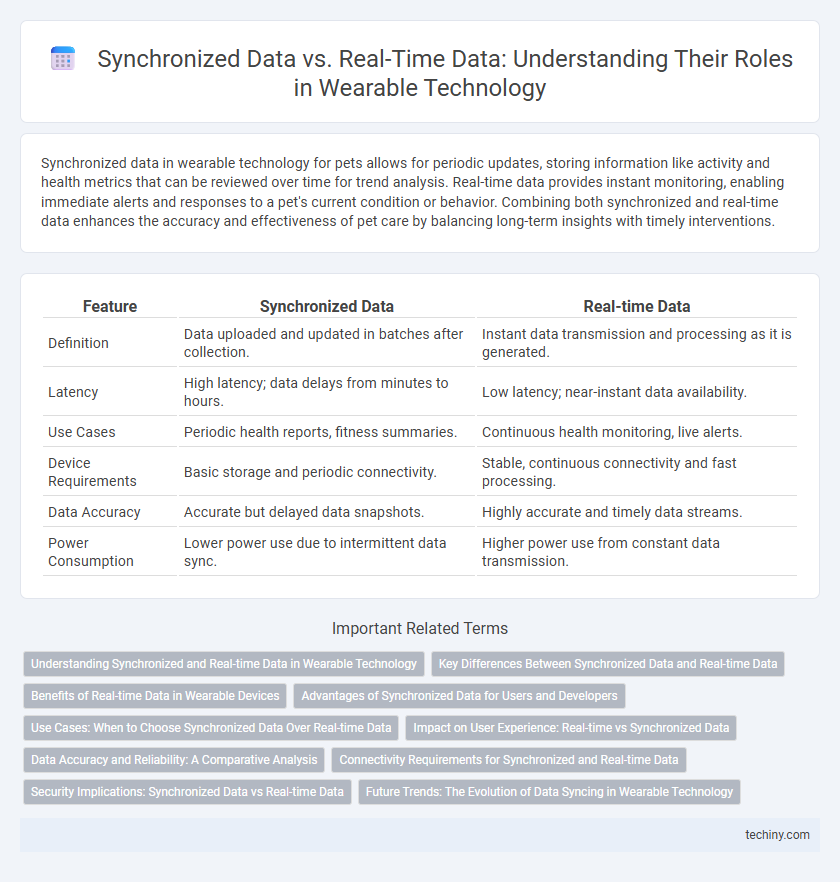Synchronized data in wearable technology for pets allows for periodic updates, storing information like activity and health metrics that can be reviewed over time for trend analysis. Real-time data provides instant monitoring, enabling immediate alerts and responses to a pet's current condition or behavior. Combining both synchronized and real-time data enhances the accuracy and effectiveness of pet care by balancing long-term insights with timely interventions.
Table of Comparison
| Feature | Synchronized Data | Real-time Data |
|---|---|---|
| Definition | Data uploaded and updated in batches after collection. | Instant data transmission and processing as it is generated. |
| Latency | High latency; data delays from minutes to hours. | Low latency; near-instant data availability. |
| Use Cases | Periodic health reports, fitness summaries. | Continuous health monitoring, live alerts. |
| Device Requirements | Basic storage and periodic connectivity. | Stable, continuous connectivity and fast processing. |
| Data Accuracy | Accurate but delayed data snapshots. | Highly accurate and timely data streams. |
| Power Consumption | Lower power use due to intermittent data sync. | Higher power use from constant data transmission. |
Understanding Synchronized and Real-time Data in Wearable Technology
Synchronized data in wearable technology refers to information collected and stored to be transmitted or analyzed at later times, enabling comprehensive trend analysis and long-term monitoring. Real-time data involves continuous, immediate transmission of sensor inputs, supporting instant feedback and prompt decision-making critical for health and fitness applications. Understanding the distinction between synchronized and real-time data enhances device functionality by balancing battery life, data accuracy, and user responsiveness.
Key Differences Between Synchronized Data and Real-time Data
Synchronized data in wearable technology refers to the process of collecting and storing information at intervals, which is then transferred in batches to a central system for analysis, ensuring data consistency and integrity. Real-time data, however, involves continuous, instantaneous transmission and processing, enabling immediate insights and responsive actions such as real-time health monitoring or fitness tracking. The key difference lies in latency and immediacy, where synchronized data prioritizes accuracy through periodic updates, while real-time data emphasizes instant availability and dynamic interaction.
Benefits of Real-time Data in Wearable Devices
Real-time data in wearable technology enables immediate health monitoring, allowing users to respond promptly to critical changes such as irregular heart rates or blood sugar levels. This instant feedback enhances personalized fitness training, optimizing workout adjustments based on current physiological metrics. Real-time synchronization supports proactive health management and improves clinical outcomes through continuous, live data transmission to healthcare providers.
Advantages of Synchronized Data for Users and Developers
Synchronized data in wearable technology enhances user experience by ensuring data consistency across multiple devices, allowing for more accurate long-term health tracking and personalized insights. Developers benefit from synchronized data through simplified data management and reduced server load, enabling efficient updates and improved app performance. This approach supports data integrity and seamless integration with other digital health platforms, fostering innovation in wearable applications.
Use Cases: When to Choose Synchronized Data Over Real-time Data
Synchronized data is ideal for wearable technology use cases where battery life, storage capacity, and intermittent connectivity are concerns, such as fitness trackers that upload step counts after workouts or sleep monitors syncing data overnight. This method reduces the need for constant data transmission, enabling devices to conserve power and process data in batches without sacrificing accuracy in long-term health trend analysis. Choosing synchronized data is beneficial when immediate feedback is unnecessary but comprehensive and accurate data collection over time is critical.
Impact on User Experience: Real-time vs Synchronized Data
Real-time data in wearable technology delivers instantaneous feedback, enhancing user engagement and enabling immediate decision-making in activities like fitness tracking and health monitoring. Synchronized data, while not instantly updated, offers comprehensive and accurate historical insights by aggregating information over time for detailed analysis. The immediate responsiveness of real-time data significantly improves user experience by providing actionable information, whereas synchronized data supports long-term progress tracking and strategic planning.
Data Accuracy and Reliability: A Comparative Analysis
Synchronized data in wearable technology ensures accuracy by systematically aligning datasets over specific intervals, minimizing discrepancies caused by time lags. Real-time data emphasizes immediacy, providing continuous updates but potentially compromising reliability due to sensor noise and transmission delays. Comparing both approaches reveals synchronized data excels in precision for analytical tasks, while real-time data supports immediate decision-making despite occasional inaccuracies.
Connectivity Requirements for Synchronized and Real-time Data
Synchronized data in wearable technology requires intermittent yet reliable connectivity to periodically update and store fitness or health metrics without continuous data transmission. Real-time data demands robust, low-latency connections such as 5G or Bluetooth Low Energy to enable instantaneous monitoring and immediate feedback, essential in critical applications like medical alerts or athletic performance tracking. Network stability, bandwidth, and energy-efficient protocols are key factors influencing the effectiveness of data synchronization versus real-time streaming in wearable devices.
Security Implications: Synchronized Data vs Real-time Data
Synchronized data in wearable technology involves periodic data transfers that reduce continuous exposure risks but may create vulnerabilities during batch uploads. Real-time data transmission offers instant monitoring benefits but increases the attack surface for hackers aiming to intercept live streams. Implementing robust encryption protocols and secure authentication mechanisms is critical to mitigating security threats in both synchronized and real-time data scenarios.
Future Trends: The Evolution of Data Syncing in Wearable Technology
Future trends in wearable technology focus on the evolution of data syncing from synchronized data models to real-time data transmission, enhancing instantaneous health monitoring and user responsiveness. Advancements in 5G connectivity and edge computing enable seamless, low-latency data exchange, supporting more accurate biometric analysis and personalized feedback. Integration of AI-powered predictive algorithms further optimizes data synchronization, paving the way for smarter, context-aware wearable devices.
Synchronized Data vs Real-time Data Infographic

 techiny.com
techiny.com